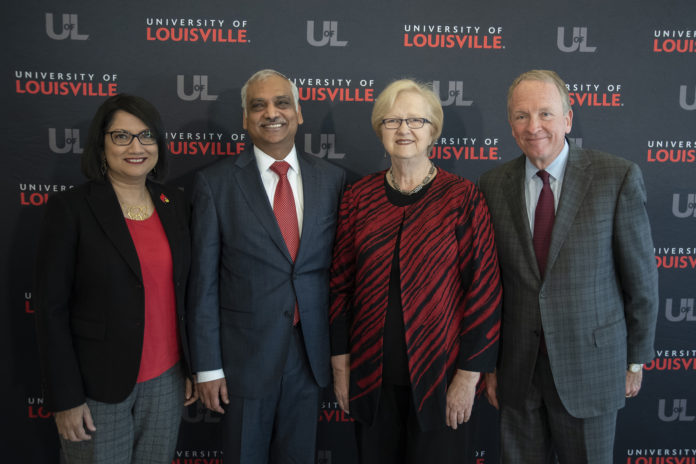
Building upon the success of the past five years, the American Heart Association, in partnership with the University of Louisville, has received a nearly $18 million, five-year renewal grant from the National Institutes of Health, funded by the Food and Drug Administration’s Center for Tobacco Products to continue support for the American Heart Association Tobacco Regulation and Addiction Center.
UofL’s center specifically will receive $8.7 million as part of the national effort.
Under the direction of Rose Marie Robertson, MD, the association’s deputy chief science and medical officer, and Aruni Bhatnagar, PhD, the Smith and Lucille Gibson Chair in Medicine at UofL, the Center examines the short- and long-term cardiovascular effects of tobacco products and the overall toxicity of tobacco products and their constituents.
The AHA Tobacco Regulation and Addiction Center received $20 million in its initial funding in 2013 through this same interagency partnership between the National Institutes of Health and the Food and Drug Administration as the FDA’s Center for Tobacco Products began its investment in the Tobacco Centers of Regulatory Science. The AHA Center is a multi-institutional network focused on creating a broad scientific base to inform the FDA’s regulation of tobacco product manufacturing, distribution and marketing.
The renewal grant awards were based on the scientific and technical merit of the applicant organizations. The AHA Tobacco Regulation and Addiction Center’s quality of research and productivity in its first five years created a strong foundation for future research and led to the renewed funding.
“We are honored to continue to be a part of this important national movement to protect the public health from the tragic consequences of tobacco product use that takes the lives of more than 480,000 Americans each year,” Robertson said. “In light of the fast-paced shifts in the landscape of new tobacco products, an accelerating trend of the use of these products by our nation’s children and an emerging generation of dual or poly-tobacco product users, the need for a better understanding of the health effects of these novel products has become even more imperative.”
During the past five years, more than 50 investigators from 12 institutions throughout the nation have collaborated on 82 publications from the center that examined topics such as the reasons behind the growing prevalence of adults and young adults who are vaping, the toxicity of flavoring chemicals used in e-cigarettes and the preliminary indicators of the growing use of poly-use, or the practice of using multiple tobacco products at the same time.
To date, researchers have found the use of tobacco products – such as traditional cigarettes, hookahs, smokeless tobacco, electronic cigarettes and e-hookahs – leads to a decrease in immune cells and prevents repair of damaged endothelial cells, increasing the risk of contracting secondary infections. Additionally, use of electronic hookahs can increase the risk of blood clots.
“Dr. Bhatnagar and his colleagues continue to demonstrate their leadership in the field of environmental cardiology, which obviously includes the use of tobacco,” said UofL President Neeli Bendapudi, PhD. “This renewal demonstrates the significance of the research being conducted and the potential impact it has on anyone who uses tobacco or similar products.
“Hopefully it will impact those who are considering using tobacco both by providing information regarding health effects that can be used in health risk warnings, and also by providing FDA data regarding the toxicity of individual constituents within tobacco-derived aerosols.”
Research at the nine institutions – Boston University, Johns Hopkins University, New York University, University of Louisville, University of Mississippi Medical Center, Wake Forest University, Stanford University, University of Iowa and National Jewish Hospital – participating in the AHA Center over the next five years will focus on understanding the toxic potential of combustible and newer forms of tobacco products, identifying the biological markers of cardiovascular injury caused by components of tobacco products and assessing the risk of heart disease for different racial and ethnic groups of people from the use of newer tobacco products.
“Identifying the biomarkers of cardiovascular injury caused by tobacco use can lead to improved standards for testing of novel tobacco products and lead to policies regulating the level of harmful chemicals present in tobacco products, thus aiming to reduce the overall burden of cardiovascular injury in the general population,” Bhatnagar said.
The researchers hope to identify specific substances from tobacco products and in their smoke or aerosols that contribute to heart disease. This includes flavoring chemicals used in electronic nicotine delivery systems such as e-cigarettes, e-hookahs, JUUL and others, along with chemical solvents used in such products.
The center also has responsibility for training the next generation of tobacco regulatory scientists who will continue research into tobacco and its health effects. To this end, 23 people have been trained as fellows in tobacco regulatory science and 11 fellowship projects have been funded over the first 5 years. The center has also funded 12 short-term projects to study emerging topics of interest to tobacco regulation.
The renewed center has been designed to retain this flexibility to respond to FDA’s research needs in a shifting landscape of tobacco use through rapid-response research funding and independent fellowship grants that can enhance the center’s research database alongside its flagship projects.
Here are some highlights from Monday’s press conference:
































